2015 VOLKSWAGEN SCIROCCO service
[x] Cancel search: servicePage 317 of 400

Check the electrolyte level of the battery regularly if the vehicle has high mileage (km), in places with a warm climate, and if the vehicle has an old battery. Otherwise the vehicle battery does not require maintenance.
Preparations
�x Prepare the vehicle for work in the engine compartment ⇒ Working in the engine compartment.
�x Open the engine hood ⇒ .
Opening and closing the battery cover
To open, fold the cover to the side in the direction of the arrow ⇒ fig. 161.
To close, fold the cover against the direction of the arrow.
Checking the vehicle battery acid level
�x If the lighting conditions are poor, use a flashlight so that you can clearly see the battery acid level indicator and tell what color it is. Never use an open flame or an unprotected light source.
�x The round battery window (“acid level indicator”) on the top of the battery changes color, depending on the battery's electrolyte level.
Color Action
Light yellow or colorless Battery electrolyte level is too low. The vehicle battery may need to be replaced. Have it checked by an authorized Volkswagen dealer or an authorized Volkswagen Service Facility.
Black Battery electrolyte level is satisfactory.
WARNING
Working on the batteries can cause serious acid burns, explosion, or electrical shock.
�x Always wear eye protection and protective gloves.
�x Sulfuric battery acid is very corrosive. It can burn unprotected skin and cause blindness. Always wear protective gloves and eye protection.
�x Never tilt the vehicle battery. Acid could spill out of the battery vents and burn you.
�x Never open a vehicle battery.
�x If you get battery acid in your eyes or on your skin, immediately rinse with cold water for several minutes and then get immediate medical attention.
�x If you swallow any battery acid, get medical attention immediately.
Charging, replacing, disconnecting, and connecting the vehicle battery
�
Page 318 of 400

Replacing the vehicle battery
The battery in your vehicle is specially developed for its location, with special dimensions and safety features. Before buying a new battery, ask an authorized Volkswagen dealer or authorized Volkswagen Service Facility what batteries are suitable with regard to electro-magnetic compatibility, dimensions, required maintenance, performance, and safety specifications. Have the battery replaced by an authorized Volkswagen dealer or an authorized Volkswagen Service Facility.
Only use maintenance-free vehicle batteries meeting standards TL 825 06 and VW 7 50 73. These standards must date from July 2012 or later.
Disconnecting the vehicle battery
If the battery must be disconnected from the vehicle's electrical system, note the following:
�x Switch off all electrical systems and devices and the ignition.
�x Unlock the vehicle before disconnecting the battery; otherwise the alarm system will go off.
�x First disconnect the negative cable (-) and then the positive cable (+) ⇒ .
Connecting the vehicle battery
�x Prior to reconnecting the battery, switch off all electrical systems and devices and the ignition.
�x Connect the positive cable (+) first and then the negative cable (-) ⇒ .
After the battery is connected and the ignition is switched on, different indicator lights may light up. They should go out after you drive a short distance at 10–12 mph (15–20 km/h). If the indicator lights do not go out, contact an authorized Volkswagen dealer or an authorized Volkswagen Service Facility and have the vehicle checked.
If the battery was disconnected for a long time, the next scheduled service may not be correctly
calculated and displayed ⇒ Instrument cluster. The maximum permissible service and maintenance
intervals are shown in the ⇒ Booklet Warranty and Maintenance.
Vehicles with Keyless Access
If the ignition will not start after reconnecting the vehicle battery, lock the vehicle from the outside and
unlock it again ⇒ Unlocking or locking the vehicle with Keyless Access. Then try to start the ignition again. If the ignition cannot be switched on, contact an authorized Volkswagen dealer, an authorized Volkswagen Service Facility, or another qualified workshop for assistance.
Automatic electrical load deactivation
If the vehicle battery drain is high, the intelligent onboard electrical system management automatically takes steps to help prevent battery drain.
�x The idle speed is increased so that the alternator provides more power.
�x The power to devices that consume a lot of electricity is cut back or switched off completely.
�x When the engine is started, the power supply to the 12 Volt sockets is temporarily interrupted.
The onboard electrical system management cannot always keep the battery from being drained. For example, the battery will drain if the engine is not running, but the ignition is switched on or the parking lights are left on for a long time when parked.
What drains the vehicle battery?
�x Long periods when the engine is not running, especially when the ignition is on.
�x Using electrical systems or devices when the engine is switched off.
�x Leaving the vehicle unlocked for several days when not in use.
�x The selector lever is left for a long period of time in any position other than Park (P) when the
ignition is switched off ⇒ Automatic transmission: Selector lever.
Page 324 of 400
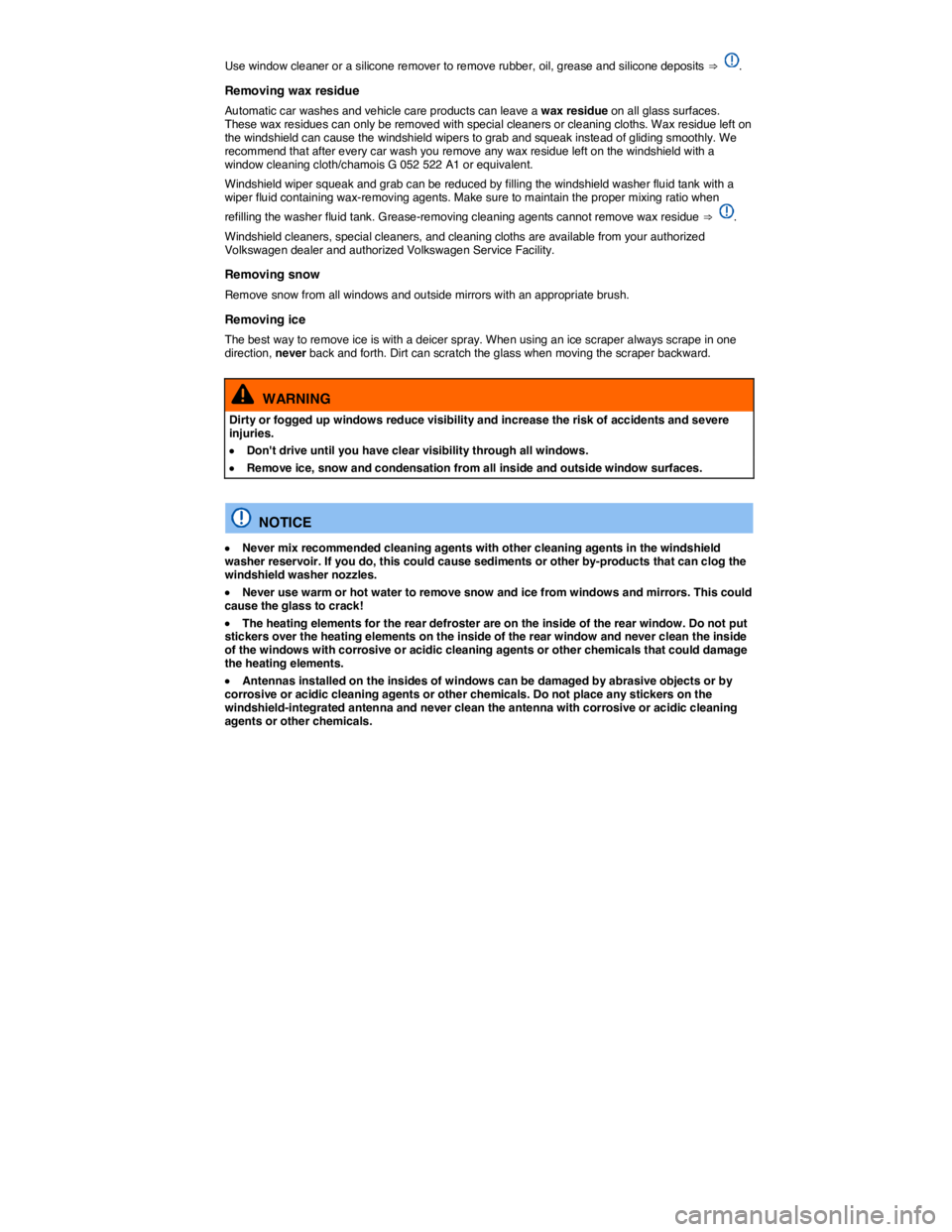
Use window cleaner or a silicone remover to remove rubber, oil, grease and silicone deposits ⇒ .
Removing wax residue
Automatic car washes and vehicle care products can leave a wax residue on all glass surfaces. These wax residues can only be removed with special cleaners or cleaning cloths. Wax residue left on the windshield can cause the windshield wipers to grab and squeak instead of gliding smoothly. We recommend that after every car wash you remove any wax residue left on the windshield with a window cleaning cloth/chamois G 052 522 A1 or equivalent.
Windshield wiper squeak and grab can be reduced by filling the windshield washer fluid tank with a wiper fluid containing wax-removing agents. Make sure to maintain the proper mixing ratio when
refilling the washer fluid tank. Grease-removing cleaning agents cannot remove wax residue ⇒ .
Windshield cleaners, special cleaners, and cleaning cloths are available from your authorized Volkswagen dealer and authorized Volkswagen Service Facility.
Removing snow
Remove snow from all windows and outside mirrors with an appropriate brush.
Removing ice
The best way to remove ice is with a deicer spray. When using an ice scraper always scrape in one direction, never back and forth. Dirt can scratch the glass when moving the scraper backward.
WARNING
Dirty or fogged up windows reduce visibility and increase the risk of accidents and severe injuries.
�x Don't drive until you have clear visibility through all windows.
�x Remove ice, snow and condensation from all inside and outside window surfaces.
NOTICE
�x Never mix recommended cleaning agents with other cleaning agents in the windshield washer reservoir. If you do, this could cause sediments or other by-products that can clog the windshield washer nozzles.
�x Never use warm or hot water to remove snow and ice from windows and mirrors. This could cause the glass to crack!
�x The heating elements for the rear defroster are on the inside of the rear window. Do not put stickers over the heating elements on the inside of the rear window and never clean the inside of the windows with corrosive or acidic cleaning agents or other chemicals that could damage the heating elements.
�x Antennas installed on the insides of windows can be damaged by abrasive objects or by corrosive or acidic cleaning agents or other chemicals. Do not place any stickers on the windshield-integrated antenna and never clean the antenna with corrosive or acidic cleaning agents or other chemicals.
Page 326 of 400
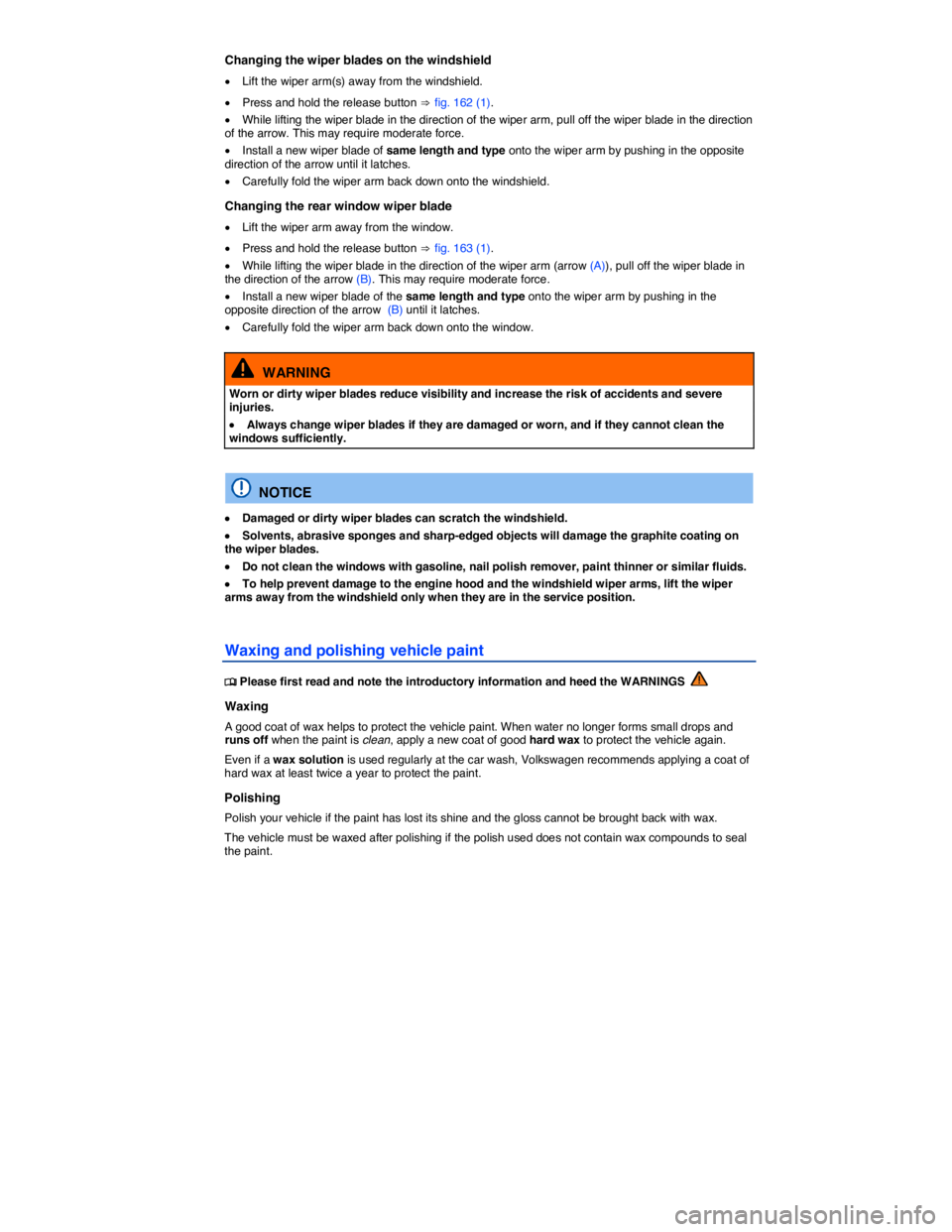
Changing the wiper blades on the windshield
�x Lift the wiper arm(s) away from the windshield.
�x Press and hold the release button ⇒ fig. 162 (1).
�x While lifting the wiper blade in the direction of the wiper arm, pull off the wiper blade in the direction of the arrow. This may require moderate force.
�x Install a new wiper blade of same length and type onto the wiper arm by pushing in the opposite direction of the arrow until it latches.
�x Carefully fold the wiper arm back down onto the windshield.
Changing the rear window wiper blade
�x Lift the wiper arm away from the window.
�x Press and hold the release button ⇒ fig. 163 (1).
�x While lifting the wiper blade in the direction of the wiper arm (arrow (A)), pull off the wiper blade in the direction of the arrow (B). This may require moderate force.
�x Install a new wiper blade of the same length and type onto the wiper arm by pushing in the opposite direction of the arrow (B) until it latches.
�x Carefully fold the wiper arm back down onto the window.
WARNING
Worn or dirty wiper blades reduce visibility and increase the risk of accidents and severe injuries.
�x Always change wiper blades if they are damaged or worn, and if they cannot clean the windows sufficiently.
NOTICE
�x Damaged or dirty wiper blades can scratch the windshield.
�x Solvents, abrasive sponges and sharp-edged objects will damage the graphite coating on the wiper blades.
�x Do not clean the windows with gasoline, nail polish remover, paint thinner or similar fluids.
�x To help prevent damage to the engine hood and the windshield wiper arms, lift the wiper arms away from the windshield only when they are in the service position.
Waxing and polishing vehicle paint
�
Page 329 of 400
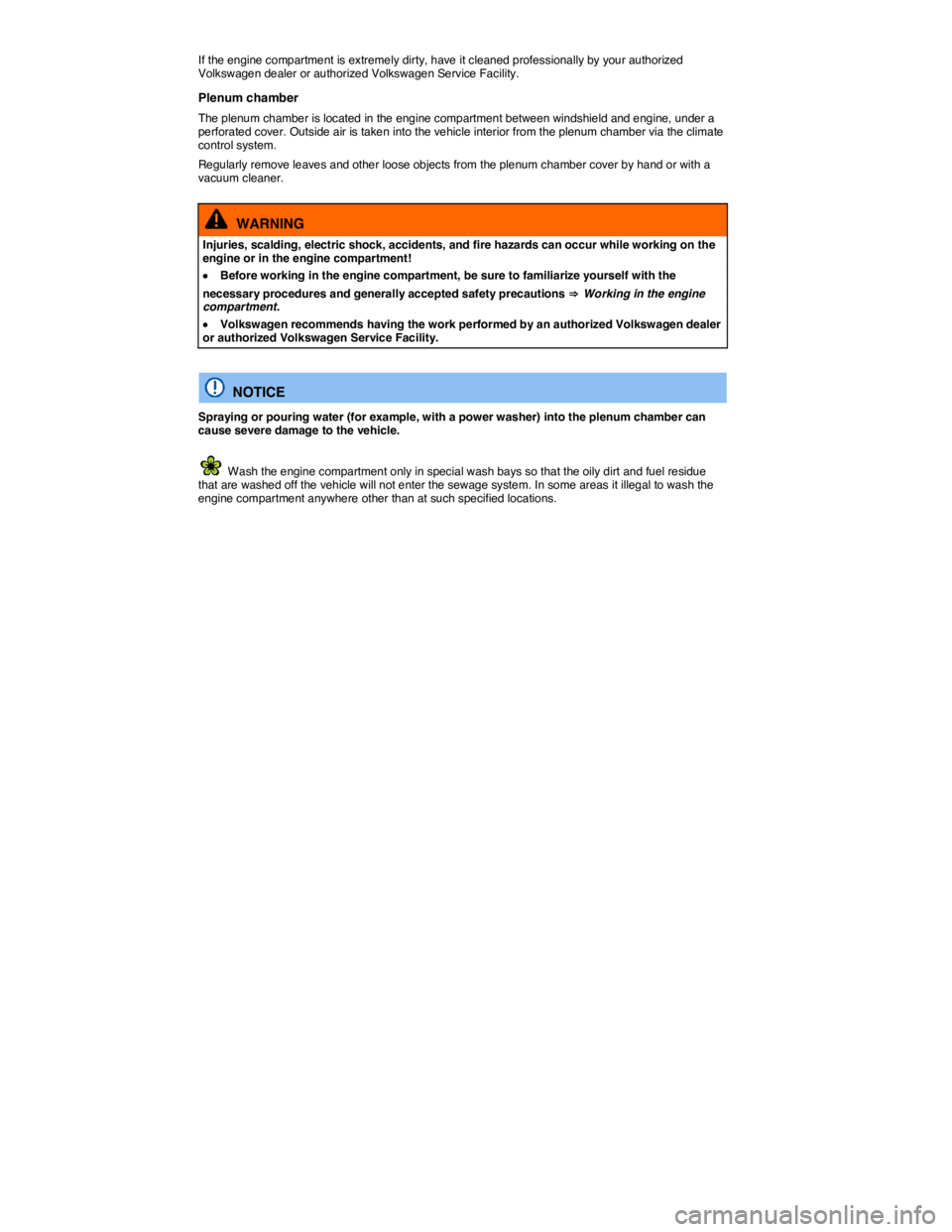
If the engine compartment is extremely dirty, have it cleaned professionally by your authorized Volkswagen dealer or authorized Volkswagen Service Facility.
Plenum chamber
The plenum chamber is located in the engine compartment between windshield and engine, under a perforated cover. Outside air is taken into the vehicle interior from the plenum chamber via the climate control system.
Regularly remove leaves and other loose objects from the plenum chamber cover by hand or with a vacuum cleaner.
WARNING
Injuries, scalding, electric shock, accidents, and fire hazards can occur while working on the engine or in the engine compartment!
�x Before working in the engine compartment, be sure to familiarize yourself with the
necessary procedures and generally accepted safety precautions ⇒ Working in the engine compartment.
�x Volkswagen recommends having the work performed by an authorized Volkswagen dealer or authorized Volkswagen Service Facility.
NOTICE
Spraying or pouring water (for example, with a power washer) into the plenum chamber can cause severe damage to the vehicle.
Wash the engine compartment only in special wash bays so that the oily dirt and fuel residue that are washed off the vehicle will not enter the sewage system. In some areas it illegal to wash the engine compartment anywhere other than at such specified locations.
Page 331 of 400
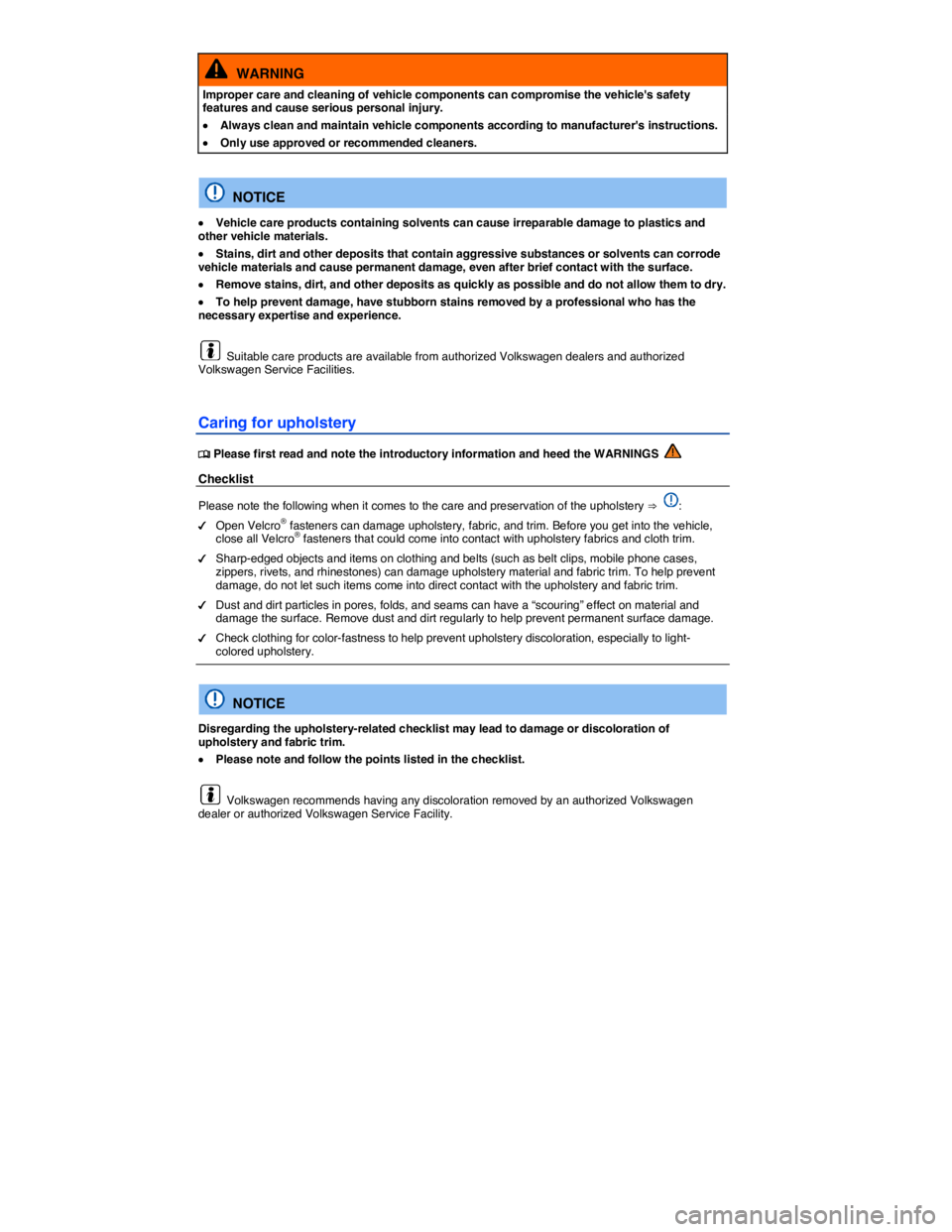
WARNING
Improper care and cleaning of vehicle components can compromise the vehicle's safety features and cause serious personal injury.
�x Always clean and maintain vehicle components according to manufacturer's instructions.
�x Only use approved or recommended cleaners.
NOTICE
�x Vehicle care products containing solvents can cause irreparable damage to plastics and other vehicle materials.
�x Stains, dirt and other deposits that contain aggressive substances or solvents can corrode vehicle materials and cause permanent damage, even after brief contact with the surface.
�x Remove stains, dirt, and other deposits as quickly as possible and do not allow them to dry.
�x To help prevent damage, have stubborn stains removed by a professional who has the necessary expertise and experience.
Suitable care products are available from authorized Volkswagen dealers and authorized Volkswagen Service Facilities.
Caring for upholstery
�
Page 333 of 400
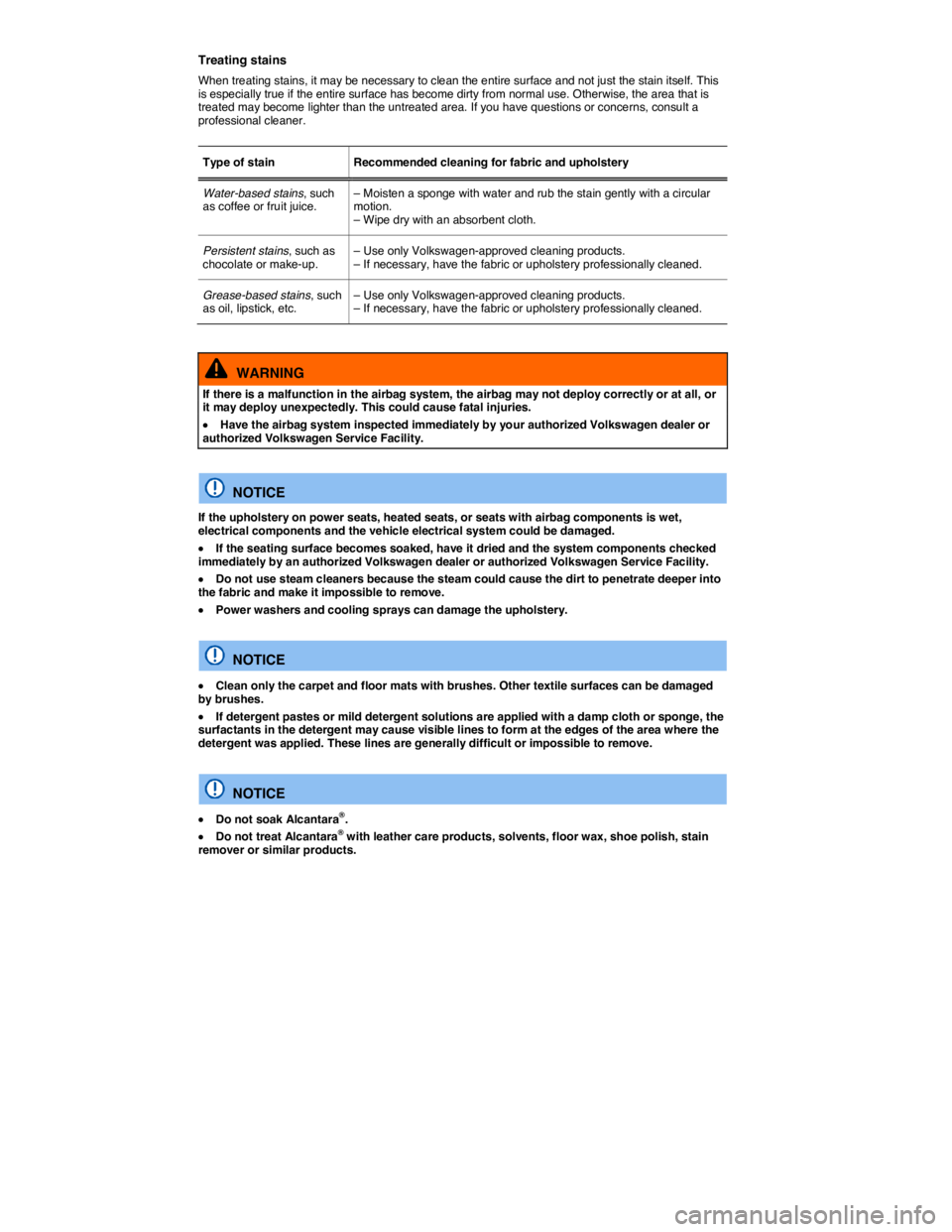
Treating stains
When treating stains, it may be necessary to clean the entire surface and not just the stain itself. This is especially true if the entire surface has become dirty from normal use. Otherwise, the area that is treated may become lighter than the untreated area. If you have questions or concerns, consult a professional cleaner.
Type of stain Recommended cleaning for fabric and upholstery
Water-based stains, such as coffee or fruit juice. – Moisten a sponge with water and rub the stain gently with a circular motion. – Wipe dry with an absorbent cloth.
Persistent stains, such as chocolate or make-up. – Use only Volkswagen-approved cleaning products. – If necessary, have the fabric or upholstery professionally cleaned.
Grease-based stains, such as oil, lipstick, etc. – Use only Volkswagen-approved cleaning products. – If necessary, have the fabric or upholstery professionally cleaned.
WARNING
If there is a malfunction in the airbag system, the airbag may not deploy correctly or at all, or it may deploy unexpectedly. This could cause fatal injuries.
�x Have the airbag system inspected immediately by your authorized Volkswagen dealer or authorized Volkswagen Service Facility.
NOTICE
If the upholstery on power seats, heated seats, or seats with airbag components is wet, electrical components and the vehicle electrical system could be damaged.
�x If the seating surface becomes soaked, have it dried and the system components checked immediately by an authorized Volkswagen dealer or authorized Volkswagen Service Facility.
�x Do not use steam cleaners because the steam could cause the dirt to penetrate deeper into the fabric and make it impossible to remove.
�x Power washers and cooling sprays can damage the upholstery.
NOTICE
�x Clean only the carpet and floor mats with brushes. Other textile surfaces can be damaged by brushes.
�x If detergent pastes or mild detergent solutions are applied with a damp cloth or sponge, the surfactants in the detergent may cause visible lines to form at the edges of the area where the detergent was applied. These lines are generally difficult or impossible to remove.
NOTICE
�x Do not soak Alcantara®.
�x Do not treat Alcantara® with leather care products, solvents, floor wax, shoe polish, stain remover or similar products.
Page 337 of 400

WARNING
Damage to safety belts reduces their overall effectiveness and increases the risk of serious personal injury and death whenever the vehicle is being used.
�x Check the condition of all safety belts regularly. If you notice that the safety belt webbing, hardware, retractor, buckle, or any other part of the safety belts is damaged, immediately have an authorized Volkswagen dealer or authorized Volkswagen Service Facility replace the safety belt with the correct replacement belt for your vehicle model and model year.
�x Never use chemical cleaning agents, solvents, or any substance that may damage or weaken the safety belt webbing or any other parts of the safety belt. Never let the belts come into contact with corrosive fluids or sharp objects. Otherwise, the safety belt webbing will be significantly weakened.
�x After cleaning, always give the safety belts time to dry completely before letting them retract. The moisture can damage the retractor and keep it from working properly.
�x Never let foreign objects or liquids get into the safety belt latch. This could prevent the belt buckles and safety belts from working properly.
�x Damaged safety belts must be replaced; they cannot be repaired.
�x Never try to repair a damaged safety belt yourself. Never remove or modify the safety belts in any way.
�x Safety belts that were subject to stress in an accident and stretched must be replaced with a correct, new safety belt, preferably by an authorized Volkswagen dealer or authorized Volkswagen Service Facility.
�x Replacement after a crash may be necessary even if a safety belt shows no visible damage. Anchorages that have been loaded must also be inspected.